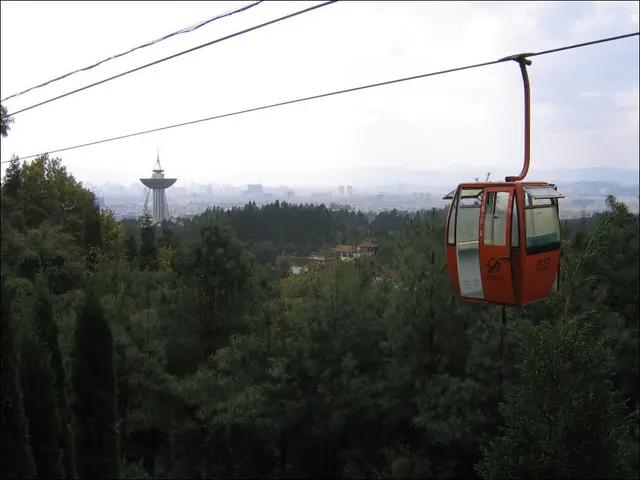Governmental body supports revision of Sariska Reserve's border layout, sparking debates over ecological implications
In the heart of India, the proposed redrawing of the boundaries of the Sariska Tiger Reserve has sparked concerns among conservationists. The fear is that this move could facilitate renewed mining activities in mineral-rich zones, potentially threatening the fragile ecosystem and undermining decades of conservation efforts.
Across the country, national parks and wildlife sanctuaries are being fractured by mining, infrastructure, and unchecked development. In the Western Ghats, mining and hydroelectric projects threaten sanctuaries like Radhanagari and Sahyadri. Similarly, copper, bauxite, and soapstone mining are gnawing at the edges of Kanha, Sunabeda, and Jamwa Ramgarh in central and eastern India.
Sariska Tiger Reserve, located in the Aravalli Range in Rajasthan, has a history of being threatened by mining activities, both legal and illegal. Mining activities have impacted its tiger population and overall ecosystem by causing habitat destruction, water depletion, increased human interference, and potential renewed poaching and human-wildlife conflict.
The forests of Sariska echo with the sounds of stone quarries due to mining activities. Approximately 50 mines, including those in villages like Khoh, Palpur, Tilwad, Gordhanpura, Mallana, Doondpuri, Jaisinghpura, and Kalwar, could fall outside the no-mining zone if the changes are approved. This move has raised alarms among conservationists about weakening protections, habitat loss, and undermining tiger recovery efforts.
The southern region of Sariska Tiger Reserve, particularly the Tehla range, holds significant marble and dolomite deposits. The Supreme Court-appointed Central Empowered Committee (CEC) has recommended approving the rationalisation of boundaries for Sariska Tiger Reserve. The rationalisation includes changes to the reserve forest area, covering 924 sq km.
While the critical tiger habitat area is increased overall from about 881 sq km to 924 sq km, the buffer zone—a vital zone that prevents external disturbances—is reduced from roughly 246 sq km to 203 sq km. Critics argue that shrinking the buffer could expose core tiger areas to more human interference, which was previously prohibited to protect tiger breeding and habitat continuity.
The CEC's recommendation is for the Rajasthan government to proceed with these changes. However, many experts doubt that the rationalisation fully addresses the ecological sensitivity or the legal and management challenges posed by the mining threat. Environmental groups highlight the risk of habitat fragmentation and degradation, which could impair tiger breeding, disrupt wildlife corridors, and reverse the reserve’s remarkable recovery from near-extinction of tigers two decades ago.
The primary concerns regarding the redrawing of Sariska Tiger Reserve boundaries center on potential facilitation of mining activities previously banned near critical tiger habitats, risking severe impacts on tiger conservation and ecological integrity. The controversy reflects a conflict between development pressures and wildlife protection imperatives.
References: [1] The Hindu, 2021, "Sariska Tiger Reserve: Mining threat looms large", https://www.thehindu.com/news/national/sariska-tiger-reserve-mining-threat-looms-large/article33979632.ece
[2] India Today, 2021, "Sariska Tiger Reserve: Mining activities threaten tiger conservation", https://www.indiatoday.in/india/story/sariska-tiger-reserve-mining-activities-threaten-tiger-conservation-1810889-2021-03-11
[3] Down To Earth, 2021, "Sariska Tiger Reserve: Boundary rationalisation threatens tiger conservation", https://www.downtoearth.org.in/news/wildlife/sariska-tiger-reserve-boundary-rationalisation-threatens-tiger-conservation-79314
[4] The Wire, 2021, "Sariska Tiger Reserve: Boundary changes could undermine tiger conservation efforts", https://thewire.in/environment/sariska-tiger-reserve-boundary-changes-could-undermine-tiger-conservation-efforts
[5] The Indian Express, 2021, "Sariska Tiger Reserve: Boundary rationalisation raises concerns over mining and tiger conservation", https://indianexpress.com/article/cities/jaipur/sariska-tiger-reserve-boundary-rationalisation-raises-concerns-over-mining-and-tiger-conservation-7868513/
- The redrawing of Sariska Tiger Reserve's boundaries has sparked concerns within the realm of environmental science, as it could facilitate renewed mining activities.
- Conservationists fear that such activities could pose a significant threat to the delicate climate-change ecosystem within the reserve.
- Mining activities have already impacted the tiger population and overall ecosystem of Sariska Tiger Reserve, causing habitat destruction, water depletion, and increased human interference.
- The potential revival of oil-and-gas and mining activities, as a result of the boundary changes, could lead to renewed poaching and human-wildlife conflict.
- The industry's intrusion into national parks and wildlife sanctuaries, through mining, infrastructure, and unchecked development, is causing the destruction of both the environment and renewable-energy resources.
- In financial terms, the escalating global-cuisines trends, driven by EU countries and the premium lifestyles associated with them, demand sustainable food-and-drink products that align with the principles of environmental science.
- The loss of critical tiger habitats due to mining activities could harm family-dynamics within the tiger population, potentially disrupting their relationships and social structures.
- The housing-market may suffer in the long run, as tiger conservation plays a key role in ensuring a balanced ecosystem, which in turn, supports the overall health of the outdoor-living environment.
- Wealth-management firms are increasingly investing in companies focused on sustainable living and renewable-energy solutions, recognizing that such initiatives can contribute positively to personal-finance growth in the long term.
- The home-and-garden sector is also benefiting from the rising interest in sustainable living, as consumers increasingly opt for eco-friendly, long-lasting, and energy-efficient products.
- Businesses that show a commitment to environmental science and sustainable living may enjoy increased popularity and stronger market positions within the premier-league of industry players.
- Advanced data-and-cloud-computing technologies are playing a crucial role in monitoring climate-change and tracking environmental changes in real-time, which aids in effective decision making when it comes to conservation and sustainable-living initiatives.
- Gardening, an integral part of sustainable living, is becoming a popular lifestyle choice, with more people embracing the lifestyle for its benefits to both their personal-growth and the environment.
- Mindfulness, learning, and goal-setting are essential skills within the education-and-self-development sector, as individuals seek to better understand and navigate the complexities of the changing world around them.
- The football industry, a significant player within the sports world, is increasingly recognizing the importance of corporate social responsibility and sustainability, with leading teams and clubs making investments in renewable-energy and environmental initiatives.
- The Champions League, one of the most prestigious competitions in European football, continues to showcase the power of corporate partnerships, with teams and brands working together to promote sustainable-living and technology-driven solutions.
- Personal-finance management is becoming increasingly important as individuals seek to navigate the complexities of the housing-market and invest in real-estate and other wealth-management strategies that align with their personal values and goals.
- Lifelong-learning, a key aspect of personal-growth, encourages individuals to embrace new ideas, find purpose, and contribute positively to their communities, regardless of the field, be it technology, food-and-drink, or sports.






